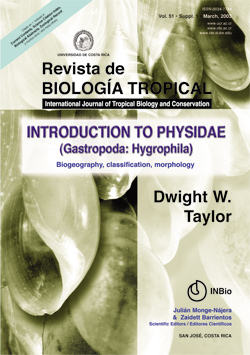Resumen
Physidae, a world-wide family of freshwater snails with about 80 species, are reclassified by progressive characters of the penial complex (the terminal male reproductive system): form and composition of penial sheath and preputium, proportions and structure of penis, presence or absence of penial stylet, site of pore of penial canal, and number and insertions of penial retractor muscles. Observation of these characters, many not recognized previously, has been possible only by the technique used in anesthetizing, fixing, and preserving. These progressive characters are the principal basis of 23 genera, four grades and four clades within the family. The two established subfamilies are divided into seven new tribes including 11 new genera, with diagnoses and lists of species referred to each. Proposed as new are: in Aplexinae, Austrinautini, with Austrinauta g.n. and Caribnauta harryi g.n., nom.nov.; Aplexini; Amecanautini with Amecanauta jaliscoensis g.n., sp.n., Mexinauta g.n., and Mayabina g.n., with M. petenensis, polita, sanctijohannis, tempisquensis spp.nn., Tropinauta sinusdulcensis g.n., sp.n.; and Stenophysini, with Stenophysa spathidophallus sp.n.; in Physinae, Haitiini, with Haitia moreleti sp.n.; Physini, with Laurentiphysa chippevarum g.n., sp.n., Physa mirollii nom.nov.; and Physellini, with Chiapaphysa g.n., and C. grijalvae, C. pacifica spp.nn., Utahphysa g.n., Archiphysa g.n., with A. ashmuni, A. sonomae spp.nn., Physella hemphilli sp.n., and Ultraphysella sinaloae g.n., sp.n.
The simplest reproductive system is found in Austrinauta of the Aplexinae; its penial complex approaches that in the related family Lymnaeidae. Within Physinae a close approximation is found in Haitia. By these two genera the two subfamilies are drawn close together. Four grades of progressive complexity are recognized: (I) penial sheath entirely muscular; (II) penial sheath with both glandular and muscular tissue; (III) penis with penial stylet or other specialization of the tip of the penis; and (IV) pore of penial canal lateral rather than terminal as in the lower grades. In both subfamilies there are clades with glandular tissue in the penial sheath, a penial sheath subdivided into two parts, and tip of penis specialized in various ways. These clades are formalized as new tribes.
Of 23 genera of Physidae, 17 occur in Pacific drainages of North and Central America, eight of these restricted to the region. Concentration of primitive genera along the Pacific coast from Mexico to Costa Rica conforms to previous observations that primitive pulmonate families are concentrated within, or along the continental margins of, the Pacific Ocean. An ancestral origin of Physidae along an ancient eastern Pacific coast is probable. From this region the several lineages have spread north, south and east in the Americas, and through Siberia to Europe.
Although Physinae have fewer genera than Aplexinae (11 v. 12), they have more species (47 v. 34). Greater land area in the temperate zone has provided more opportunity for speciation of Physinae, in contrast to the generally tropical and warm-temperate range of Aplexinae. Furthermore, 10 species of Physinae are localized in individual lakes, whereas Aplexinae are not lake-dwellers.
Both well-developed egg strings and capsular strings are found in the spawn of Sibirenauta elongatus. These structures have been known in Lymnaeidae, but not hitherto in Physidae; they are a link with some marine groups, such as Siphonariidae. Spiral color bands and white streaks in the shell of Mexinauta recall those in Lancidae (Lymnaeacea), whereas the radula of Physidae is like that of Chilinidae. Physidae thus show affinities to various basal stocks of aquatic pulmonates; no clear-cut sister-group can be recognized.
Most species have a restricted range; out of 55 with sufficiently detailed information for analysis, 25 are limited to a single 1ºx1º quadrangle. Only a few species are widespread, on one or even two continents. Accordingly, more species of Physidae are threatened by habitat destruction than in other families of Hygrophila with generally wider distributions.
Other features are a key to genera; catalog of more than 430 names applied to living Physidae, with original reference, type locality, and location of type specimens; summary of museums with types; and glossary.
Comentarios

Esta obra está bajo una licencia internacional Creative Commons Atribución 4.0.
Derechos de autor 2003 Revista de Biología Tropical


